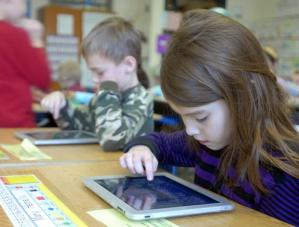
Technology in Education
Technology in Education
Technology is revolutionizing education. There is no doubt that the wave of education future will entail smartboards, tablets, touchscreens and all manner of interactive material for students. The generation of school age students has embraced the tech trends will alarming skill and alacrity. There are several reasons why technology will benefit this generation of learners and it is not just because they take to the iphone faster than a landline. There are several case studies that demonstrate how critical it is that we understand the changing environment of education and allow the new model of learning to adapt to a new world of learners.
The smartboard

Source: chcemergtech.wikispaces.com
The Minnesota Science Teachers Education Project has launched a fully interactive lesson plan that all teachers can access for fully developed lesson plans and presentations. The smartboard is a great tool for presenting to a classroom full of eager learners who learn best through visuals and hands on demonstrations. Teacher’s use predesigned lessons — a study of spider webs, for example — to teach the state standards to their students and they have myriad ways to demonstrate and display information. Students can assist with the smartboard by helping with vocabulary review, circling and labeling parts of the diagram. The possibilities continue ad infinitum for using the smartboard as a teaching tool for students.
The tablet
Post instruction, students benefit from using tablets, such as an ipad or the bamboo touch screen to reinforce concepts from a lesson. Northern Lights Public School in Aurora, Ontario has essentially replaced paper in their classrom with a tablet PC that transforms students from passive receivers of knowledge to active participants in the learning process. Post lesson, students use the tablets to work at their own pace to reinforce concepts and review portions of the lecture that needed clarification. Teachers in the school district assign interactive homework and are able to track each individual students progress as they reinforce the concepts at their own pace. The very format of reinforcement and post-instruction has changed the way students process and relearn information. The delivery mode of information and reinforcement have changed to accomodate slow learners, visual learners and kinesthetic learners. The transformation to a paperless classroom had completely altered the way students perceive new information. All textbooks will soon be available as a downloadable program and the bulky, behemoth World History textbook, flooded with graphics, glossy paper and an index the size of a small solar system will soon be used as doorstops (given we still have doors).
CAT

Source: AGBU Alex and Marie Manoogian High School
Computerized Adaptive Tests, though limited at this point to a small, but growing, number of tests such as the GRE, the ASVAB or the GMAT, CA Tests will be the next wave of education as students are assessed at their level and given problems based on their performance. The benefits of computerized adaptive tests give students a full assessment of their capabilities and, as an added benefit, prevent cheating, since each student will be given a different range of questions based on their own ability and electronic algorithms that manipulate the order and versions of each test that children use (yes, technology may be changing, but human nature is still the same). Though software is still under development for this type of testing, it is only a matter of time before individual classrooms and standardized tests (such as the ISEE, SAT, ERB, etc) begin using CA tests as a norm. Bubble sheets and test booklets will become as obsolete as an overhead projector (remember those? Or how about flannel graphs?).
With this wave of technology, we need to carefully consider both sides of the issue. The cost of technology, though doable for many, is still staggeringly high for lower achieving areas and this change in education may stretch the education gap to an education chasm. The replacement for a tablet, smartboard or computer for any student is still far greater than the $30 glossy student edition through Prentice Hall. There was a point when equal access to books was the debate and a textbook for each student was considered the great novelty and remarkable gift for the kids. Will the novelty of flashy visuals in the classrooom wear off and leave educators with storerooms of obsolete gizmos that students cannot use? With the surge in technology and rapid changes, the flashy new gadgets made available to students will never replace the value of a dedicated educator or passionate learner.
Sources
https://serc.carleton.edu/sp/mnstep
Experiences from a wireless-enabled tablet classroom
Jodi Tutty, Barbara White, Robert Pascoe
https://www.psych.umn.edu/psylabs/catcentral/
https://www.pcworld.com/article/114383/tablet_pcs_go_to_school.html

